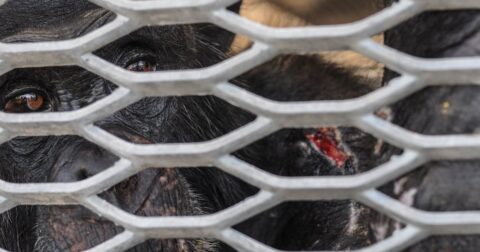News
Could Genetically Engineered Fungus Help Replace Animal Protein?
Breakthroughs•5 min read
Feature
Environmental organizations’ desire to protect the planet is admirable, but their misplaced trust in animal testing could be doing more harm than good.


Words by Samantha Saunders
On a cold November morning in Helsinki, with the sun barely above the horizon, a small group of people makes their way through the drizzle to a tall, brightly-lit building: the European Chemicals Agency’s headquarters. Past the security guards, the assembly continues down to a wood-paneled meeting room in the basement, where they exchange pleasantries before drawing the battle lines. Animal advocates sit on one side of the table, opposite not the industry executives or government officials one might expect, but environmentalists.
Under normal circumstances, protections for animals and the planet are complementary. Eating plant-based foods significantly reduces one’s environmental footprint; dietary staples like whole grains, fruits, vegetables, and nuts generate fewer greenhouse gas emissions and require significantly less land than animal-derived foods. Wild animals’ well-being and survival depend on a healthy environment. Human activity—including deforestation, mining, and subsequent climate change acceleration—destroys global habitats, causing their displaced occupants suffering and death. Animal advocates and environmentalists share an interest in protecting the environment from humanity’s damaging impacts, including those of animal agriculture.
But there’s a contentious intersection of environmental and animal concerns that some might not be so familiar with. As required by law in most of the world, including the U.S. and Europe, industrial chemicals are tested on animals in laboratories with the misguided aim of protecting the environment and its wild inhabitants from the chemicals’ potentially toxic effects. When officials want to propose or amend chemical regulations, stakeholders meet—as in Helsinki—to designate associated toxicity tests. Environmental lobbyists, believing that detecting chemicals’ toxic effects in animals in laboratories is the best way to protect the biosphere, generally push for more tests on animals. Animal advocates, opposing the suffering and death inflicted upon animals by tests that lack scientific robustness, support the use of non-animal methods. Where animal testing is concerned, those who share a common interest in protecting the planet become staunch enemies.
European officials are currently deciding how best to adequately control the health risks posed by a category of chemicals called endocrine disruptors. These natural and manmade chemicals, including lead and Bisphenol A, perturb both animals’ and humans’ hormonal systems, leading to outcomes including infertility and behavioral changes. Researchers expect that there are many more as yet unidentified chemicals with endocrine-disrupting properties, whose control requires a robust identification system. Animal advocates and environmentalists, however, disagree about animal testing’s role in such a system.
Animal advocates’ concerns about tests on animals are not limited to the suffering and death they inflict on sentient creatures; they argue these tests do little to protect the environment. Notorious for their lack of reliability, tests on animals often produce spurious and irreproducible results. Both animal strain and laboratory were found to affect animal tests for endocrine disruptors’ results, forming a weak foundation for risk management decisions. Beyond reliability, these tests also lack relevance to the species they aim to protect. Fish toxicity tests typically use zebrafishes, minnows, carps, medakas, guppies, or bluegills—species selected for their ease of handling and adaptation to the laboratory, who can’t possibly represent thousands of wild species and their complex interactions with each other and their habitats. Basing chemical risk management decisions on unreliable and irrelevant animal test results undermines the objective of protecting the environment and its wild inhabitants.
Perhaps crude tests on animals used to be the best option, but non-animal approaches to chemical testing are the most ethical and effective way forward. Using computer modeling and cell-based methods, combined with an advanced understanding of mechanisms of toxicity, scientists are finding these approaches more reproducible and relevant to the species and habitats they aim to protect, with non-animal methods already outperforming animal tests in some cases. Devised as part of an effort to end its support and funding for chemical tests on mammals by 2035, the U.S. Environmental Protection Agency’s endocrine disruptor screening program takes advantage of advanced cell-based and computational methods to avoid much animal testing that would otherwise be required. Environmentalists and animal advocates can regain common ground by promoting a transition to non-animal approaches that better serve the environment and wild animals.
Environmental organizations’ desire to protect the planet and its wild creatures is admirable. Misplaced trust in animal tests, however, must not enable the continued exploitation of animals in laboratories. Animal advocates and environmentalists both have a stake in protecting the environment and can strive to work more effectively together.